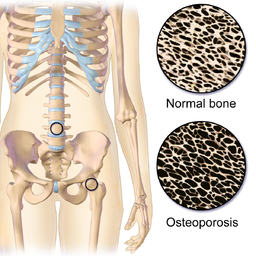Since osteoporosis usually goes undetected until a fracture happens, it is sometimes referred to as an unseen disease. Because there are no visible signs of the internal degradation occurring, the slow weakening of bones remains unnoticed.
Nahid J. Rianon, MD, a geriatrician at UT Physicians Center for Healthy Aging – Bellaire Station, explained that although bone density loss occurs in both men and women early in life, the effects typically don’t become noticeable until much later. Osteoporosis is particularly sneaky because of these delayed visible signs of bone loss.

The trabecular bone is often where osteoporosis first manifests its effects. Bone density examinations are frequently performed on the spine and hips since these locations are rich in this type of bone. It is commonly advised that males should begin having their bone density tested at age 70 and women at age 65. Some circumstances, though, such a family history or other medical issues, can call for earlier testing.
Technological developments have greatly improved the accuracy of osteoporosis evaluations. The Trabecular Bone Score (TBS), which provides a more thorough assessment of bone health, is one such innovation. Patients with diabetes or those on long-term drugs that impact bone density will benefit most from this technology. Healthcare professionals may now more accurately identify structural deterioration and forecast the chance of future fractures by incorporating specialized software into bone density equipment. TBS combined with conventional bone density ratings at UT Physicians offers a complete picture of an older person’s bone health. The Texas Medical Center clinic of UT Physicians Internal Medicine currently has this state-of-the-art instrument available.
Osteoporosis’s effect on bones is best illustrated by Dr. Rianon, a professor at McGovern Medical School at UTHealth Houston and holder of the Memorial Hermann Chair in geriatrics. She compares bones to the structure of a building, which becomes weaker and eventually collapses due to the deterioration of its supporting columns. Fractures result from these weaker bones being unable to bear the weight under intense pressure.

Patients who break even if their bone density tests show no osteoporosis are a regular situation that Dr. Rianon deals with. This paradox highlights how crucial the Trabecular Bone Score is. TBS is valuable because it can identify low-quality bone before noticeable changes in bone density occur, according to Dr. Rianon. Early detection makes it possible to start treating patients to avoid fractures in the future, which has a big influence on my treatment plans and the patients’ capacity to remain independent.
Dr. Rianon also pointed out that a decrease in height of more than 2.5 inches, which could be the consequence of structural degradation in the spine, is a crucial sign of probable vertebral fractures. It’s interesting to note that pain is experienced by only 33% of people with vertebral fractures, suggesting many are not aware they have a fracture.
The World Health Organization created the Fracture Risk Assessment Tool (FRAX) to assist in determining fracture risk. This online tool, intended for those aged 40-90, calculates an individual’s 10-year chance of hip fracture and major osteoporotic fracture. Using a variety of algorithms, FRAX offers a customized risk assessment based on each person’s health profile and medical history.
Since everyone experiences bone loss, prevention strategies for strong bones should ideally begin early in life. Dr. Rianon pointed out that women lose bone more quickly during menopause because of an estrogen shortage. Between the ages of 20 and 30, bone mass peaks, and then bone loss starts. Throughout childhood and maturity, bone health is greatly influenced by nutrition.
Dr. Rianon stressed that poor nutrition throughout the formative years causes a decrease in peak bone mass, meaning that people lose bone at a lower starting point. Furthermore, maintaining current bone mass is hampered by poor nutrition in later age. All of the essential elements that go into building our bodies—protein, carbs, and fats—are included in nutrition. Because calcium and vitamin D levels are essential for bone health, healthcare professionals concentrate on them while treating patients. Osteoporosis medications are useless if your vitamin D levels are below normal. Variations in blood calcium levels could be a sign of underlying medical conditions.
Dr. Rianon stated that it’s critical to rule out any underlying diseases that could be causing aberrant amounts of calcium and vitamin D. This is more than just making sure you’re getting enough calcium and vitamin D. For example, problems with the parathyroid hormone gland or kidneys could exist.”
Osteoporosis can be treated with a variety of drugs, from older ones that prevent bone loss to more recent ones that encourage bone growth. Bone resorption, or the dissolution of bones, occurs more quickly in older adults than in younger ones. Dr. Rianon emphasized that there are strict guidelines for the length of time that these drugs should be used. Certain medications can be taken continuously with sporadic breaks, sometimes referred to as “drug holidays,” while others have a lifetime usage limit of one or two years. Following these guidelines is essential since non-compliance might change the cellular makeup of bone, raising the possibility of various fractures. Dr. Rianon emphasized the significance of seeing a physician in order to ascertain the best drug and length of therapy based on unique medical profiles.



Leave a Reply